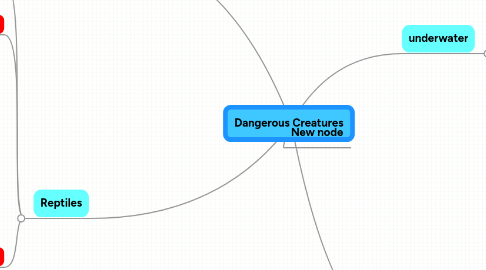
1. underwater
1.1. Jelly fish
1.1.1. Contact with a jellyfish tentacle can trigger millions of nematocysts to pierce the skin and inject venom,[30] yet the sting of only some jellyfish species causes an adverse reaction in humans.
1.2. Stingray
1.2.1. The stingray's spine, or barb, can be ominously fashioned with serrated edges and a sharp point. The underside may produce venom, which can be fatal to humans, and which can remain deadly even after the stingray's death
1.3. Puffer Fish
1.3.1. They are poor in swimming
1.3.2. They can quickly ingest huge amount of water to turn themselves into a virtually inedible ball several times their normal size
1.3.3. New contain tetrodotoxin, a substance that makes them foul tasting and often lethal to fishnode
1.3.4. There is enough toxin in one pufferfish to kill 30 adult humans, and there is no known antidote.
2. Flying
2.1. Bees
2.1.1. can kill
2.1.2. have stinger
2.1.3. are often kill in beehives by hungy bears
2.2. Eagles
2.2.1. Could eat humans
2.2.2. Are powerful
2.2.3. Use soaring or sprinting flight to hunt
3. Land
3.1. Lion
3.1.1. They often work together to prey upon antelopes, zebras, wildebeest, and other large animals of the open grasslands.
3.2. Leapord
3.2.1. When human settlements are present, leopards often attack dogs and, occasionally, people
3.3. Tiger
3.3.1. Despite their fearsome reputation, most tigers avoid humans; however, a few do become dangerous maneaters.
4. New node
5. Reptiles
5.1. Komodo Dragon
5.1.1. When a victim ambles by, the dragon springs, using its powerful legs, sharp claws and serrated, shark-like teeth to eviscerate its prey
5.2. Aliigator
5.2.1. Adult alligators are apex predators critical to the biodiversity of their habitat. They feed mainly on fish, turtles, snakes, and small mammals. However, they are opportunists, and a hungry gator will eat just about anything, including carrion, pets and, in rare instances, humans
5.3. Anaconda
5.3.1. Physical Features
5.3.1.1. The green anaconda is the largest snake in the world, when both weight and length are considered. It can reach a length of 30 feet (9 meters) and weigh up to 550 pounds (227 kilograms).
5.3.1.2. To picture how big that is, if about five ten-year-olds lie down head to foot, they'd be about the length of this huge snake. And it'd take about 11 kids to weigh as much as one anaconda. These snakes can be as big around as a grown man. They have some giant relatives, too.
5.3.2. Diet
5.3.2.1. The giant snake opens its mouth wide enough to swallow its victim—sometimes fish or caiman (relatives of crocodiles) and even jaguars and small deer. Anaconda jaws are held together with stretchy ligaments so they can open wide enough to swallow prey whole.
5.3.3. Habitat
5.3.3.1. The green anaconda is an aquatic snake. It lives in swamps, marshes, and slow-moving rivers. It's nocturnal, or active at night. An anaconda will hunt on land, but it prefers to stay in the water, where its huge size feels less bulky.
5.3.3.2. Green anacondas live in the tropics of South America, as far south as Argentina, east of the Andes mountain range. Most are found in the areas along the Amazon and Orinoco rivers.
5.3.4. Danger Posed
5.3.4.1. The green anaconda is a member of a family of snakes called constrictors. Constrictors are not venomous snakes. They don't kill prey by delivering venom through a bite. Instead, constrictors wrap their bodies around their prey and squeeze until it stops breathing.
5.3.4.2. The green anaconda can move swiftly both underwater and at the surface. To hunt, it lies at the surface of a pond or stream waiting for an animal to stop by for a drink. Its nostrils are located on the top of its snout, so it can breathe while almost entirely submerged.
